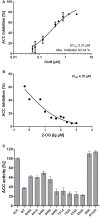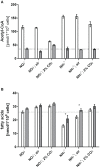Interaction of the Nitrogen Regulatory Protein GlnB (PII) with Biotin Carboxyl Carrier Protein (BCCP) Controls Acetyl-CoA Levels in the Cyanobacterium Synechocystis sp. PCC 6803
- PMID: 27833596
- PMCID: PMC5080355
- DOI: 10.3389/fmicb.2016.01700
Interaction of the Nitrogen Regulatory Protein GlnB (PII) with Biotin Carboxyl Carrier Protein (BCCP) Controls Acetyl-CoA Levels in the Cyanobacterium Synechocystis sp. PCC 6803
Abstract
The family of PII signal transduction proteins (members GlnB, GlnK, NifI) plays key roles in various cellular processes related to nitrogen metabolism at different functional levels. Recent studies implied that PII proteins may also be involved in the regulation of fatty acid metabolism, since GlnB proteins from Proteobacteria and from Arabidopsis thaliana were shown to interact with biotin carboxyl carrier protein (BCCP) of acetyl-CoA carboxylase (ACC). In case of Escherichia coli ACCase, this interaction reduces the kcat of acetyl-CoA carboxylation, which should have a marked impact on the acetyl-CoA metabolism. In this study we show that the PII protein of a unicellular cyanobacterium inhibits the biosynthetic activity of E. coli ACC and also interacts with cyanobacterial BCCP in an ATP and 2-oxoglutarate dependent manner. In a PII mutant strain of Synechocystis strain PCC 6803, the lacking control leads to reduced acetyl-CoA levels, slightly increased levels of fatty acids and formation of lipid bodies as well as an altered fatty acid composition.
Keywords: BCCP; GlnB (PII); Synechocystis sp. PCC 6803; acetyl-CoA; cyanobacteria.
Figures





Similar articles
-
The bacterial signal transduction protein GlnB regulates the committed step in fatty acid biosynthesis by acting as a dissociable regulatory subunit of acetyl-CoA carboxylase.Mol Microbiol. 2015 Mar;95(6):1025-35. doi: 10.1111/mmi.12912. Epub 2015 Jan 30. Mol Microbiol. 2015. PMID: 25557370
-
Transcriptional regulation of acetyl CoA and lipid synthesis by PII protein in Synechococcus PCC 7942.J Basic Microbiol. 2018 Feb;58(2):187-197. doi: 10.1002/jobm.201700467. Epub 2017 Dec 5. J Basic Microbiol. 2018. PMID: 29205418
-
Search for novel targets of the PII signal transduction protein in Bacteria identifies the BCCP component of acetyl-CoA carboxylase as a PII binding partner.Mol Microbiol. 2014 Feb;91(4):751-61. doi: 10.1111/mmi.12493. Epub 2014 Jan 6. Mol Microbiol. 2014. PMID: 24329683
-
Nitrogen regulation in bacteria and archaea.Annu Rev Microbiol. 2007;61:349-77. doi: 10.1146/annurev.micro.61.080706.093409. Annu Rev Microbiol. 2007. PMID: 17506680 Review.
-
Keeping in touch with PII: PII-interacting proteins in unicellular cyanobacteria.Plant Cell Physiol. 2007 Jul;48(7):908-14. doi: 10.1093/pcp/pcm072. Epub 2007 Jun 12. Plant Cell Physiol. 2007. PMID: 17566056 Review.
Cited by
-
The Signal Transduction Protein PII Controls Ammonium, Nitrate and Urea Uptake in Cyanobacteria.Front Microbiol. 2019 Jun 25;10:1428. doi: 10.3389/fmicb.2019.01428. eCollection 2019. Front Microbiol. 2019. PMID: 31293555 Free PMC article.
-
Dissection of the Mechanisms of Growth Inhibition Resulting from Loss of the PII Protein in the Cyanobacterium Synechococcus elongatus PCC 7942.Plant Cell Physiol. 2021 Sep 24;62(4):721-731. doi: 10.1093/pcp/pcab030. Plant Cell Physiol. 2021. PMID: 33650637 Free PMC article.
-
Tuning the in vitro sensing and signaling properties of cyanobacterial PII protein by mutation of key residues.Sci Rep. 2019 Dec 12;9(1):18985. doi: 10.1038/s41598-019-55495-y. Sci Rep. 2019. PMID: 31831819 Free PMC article.
-
The PII protein interacts with the Amt ammonium transport and modulates nitrate/nitrite assimilation in mycobacteria.Front Microbiol. 2024 Mar 25;15:1366111. doi: 10.3389/fmicb.2024.1366111. eCollection 2024. Front Microbiol. 2024. PMID: 38591044 Free PMC article.
-
Small but Smart: On the Diverse Role of Small Proteins in the Regulation of Cyanobacterial Metabolism.Life (Basel). 2020 Dec 1;10(12):322. doi: 10.3390/life10120322. Life (Basel). 2020. PMID: 33271798 Free PMC article. Review.
References
LinkOut - more resources
Full Text Sources
Other Literature Sources
Miscellaneous

